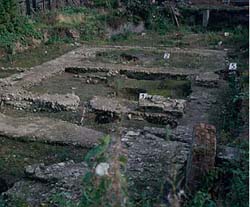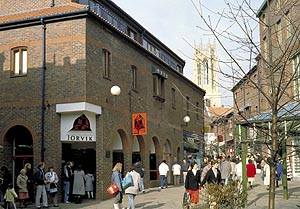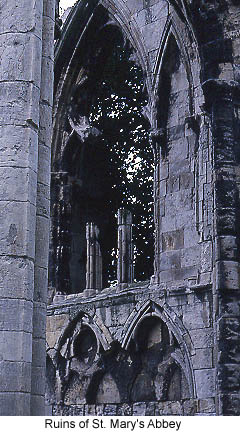Uncovering the Archaeological Bounty of York
by Sara Polsky
 With its varied and likely
continuous occupation from Roman times through the present, York
is an excellent spot for the archaeology enthusiast to gain
fieldwork experience. The city is home to many already-excavated
sites of archaeological interest, and visitors may also immerse
themselves more thoroughly into the city's history by
participating in a training dig. With its varied and likely
continuous occupation from Roman times through the present, York
is an excellent spot for the archaeology enthusiast to gain
fieldwork experience. The city is home to many already-excavated
sites of archaeological interest, and visitors may also immerse
themselves more thoroughly into the city's history by
participating in a training dig.
Some scholars argue that York was inhabited prior to the arrival
of the Romans, but archaeologists know for sure only that the
Romans, under Cerialis's legion, founded a city at York in 71 AD
and built a fortress, which was known as Eboracum, at that time.
The fortress, originally constructed out of timber and then
reconstructed from stone in the second and third centuries,
served as the center of Roman Britain's road network. The
immediate post-Roman history of the fortress area is still
somewhat in dispute among historians and archaeologists.
Historical records, like Bede's Ecclesiastical History of the
English People, suggest that Prince Edwin of York ordered the
construction of a wooden church, which later became a stone
church, on the former fortress site sometime during the seventh
century. Archaeological records provide less definite evidence
of such early post-Roman use, but do suggest that the site was
used later, during the late Anglo-Saxon period, after the Viking
invasion, and through the Norman Conquest of 1066. By 1472, the
building had achieved the shape of the present York Minster.
After the Romans' departure from Britain, York was called
Eoforwic and then, during the Viking period, Jorvik.
Archaeologists have uncovered evidence of a 7th-9th century
settlement to the south of York's walls. According to
information provided by the York Archaeological Trust, people
began to move into the area just outside the former fortress
toward the end of the ninth century. From that time, the
present-day street system developed. Medieval York had more
hospitals than London and served as a port. Members of all four
medieval monastic orders resided there. Through the 16th and
18th centuries, York served more of a social function than its
earlier religious and mercantile purposes. Well-preserved
structures survive from both of these periods, including the
Merchants Adventurers' Hall of 1357 and the Georgian period
Fairfax House, and are open to visitors.
York's Many Archaeological Strata
 Already-completed excavations in York have led to the
creation of exhibits and museums for the
archaeologically-intrigued who would prefer to bypass excavation.
Many excavations have been completed by the York Archaeological
Trust, which has excavated over 1000 sites in the area since its
founding in 1972. Perhaps the best-known result of these
excavations is Jorvik, a museum devoted to York's Viking
past. Already-completed excavations in York have led to the
creation of exhibits and museums for the
archaeologically-intrigued who would prefer to bypass excavation.
Many excavations have been completed by the York Archaeological
Trust, which has excavated over 1000 sites in the area since its
founding in 1972. Perhaps the best-known result of these
excavations is Jorvik, a museum devoted to York's Viking
past.
The Vikings conquered York in 866 AD, and they had established
their Jorvik settlement by 876. Though pre-Viking York had
flourished as an ecclesiastical center and a center for learning,
it had been a fairly small community by later medieval standards.
Following the Viking settlement, though, York grew: the
post-Norman Conquest Domesday Book records the York population as
the second-largest of any settlement in England. As an
archaeological site, too, Jorvik proved flourishing. The museum
contains numerous well-preserved artifacts, including wood, a
notoriously perishable archaeological material. From
November-March, Jorvik is open from 10 AM to 4 PM. From
April-October, the museum is open from 10 AM to 5 PM. Visiting
the museum costs £7.45, or £5.25 for children ages
5-15.

The York Archaeological Trust is currently undertaking numerous
other archaeological and historical investigations in the York
area, including an oral history collection related to World War
II, recording work at Fountains Abbey in North Yorkshire, and an
examination of the Ripon Horn, a cattle horn said to have been
given to the city of York by King Alfred the Great. Though these
projects provide less visible material for interested visitors,
the Trust does hold lunchtime lectures, Saturday workshops, and
longer-term exhibits about its recent work and broader
archaeological topics.
The York Archaeological Trust Those
interested in participating in excavation in York may also turn
to the York Archaeological Trust, which runs a training dig every
summer. The current site under investigation is the precinct of
St. Mary's Abbey. The site dates from the Roman period, and in
fact sits next to a Roman road, though the abbey itself was
constructed in 1088 for the Benedictine order. The abbey
suffered one serious religious upset, when a group of
dissatisfied monks left St. Mary's to found Fountains Abbey as a
community for members of the Cistercian order. But the abbey
remained functional until the 1539 Dissolution of the
monasteries, according to the Trust.
As an archaeological site, St. Mary's is unique because it is an
urban site of the kind rarely open to volunteer excavators.
Students, who are required to be over 16 years old unless they
make special arrangements with the Trust, may attend one- or
two-week courses or one to two-day "tasters" to learn
excavation basics. Both of the longer courses include full days
of excavation, broken up by lectures or seminars on ceramics,
stratigraphy, and artifacts. "Taster" classes focus on
excavation, recording, and methods of cleaning archaeological
finds. Those with prior excavation experience may qualify for
free placements at the site, and will be required to assist in
running the project. Though the dates for the current field season
are not yet available, the 2005 excavation ran from June 20th
through September 9th. The one week course costs £195 (or
£285 with accommodation), the two week course costs
£370 (£495 with accommodation), and the tasters cost
£50 for one day and £95 for two days (plus £40
per additional day). Placements are free, plus £70 per
week for accommodation and a £20 administrative fee.
For other work in Yorkshire and Lincolnshire, volunteers can
contact Humber Field Archaeology, a professional group that
sometimes accepts volunteers on its excavations and for artifact
cleaning and analysis.
Related Articles:
- Jorvik: The Viking City of York, by Brenda Lewis
- https://www.timetravel-britain.com/articles/towns/jorvik.shtml
- The Treasures of York, by Pearl Harris
- https://www.timetravel-britain.com/articles/towns/york.shtml
- Timeline: York, by Darcy Lewis
- https://www.timetravel-britain.com/articles/towns/yorktime.shtml
More Information:
We regret that we no longer have the resources to maintain up-to-date links and/or hours and pricing details for the various sites and attractions listed on this website. For more information about the location(s) listed above, please use your favorite search engine or visit Wikipedia.
Sara Polsky's writing has appeared or is forthcoming in The Christian Science Monitor, Renaissance Magazine, Student Traveler, and other publications, and she has participated in archaeological excavations in New Jersey and Massachusetts. She is a 2007 graduate of Harvard University.
Article © 2006 Sara Polsky
Excavation and St. Mary's photos © Moira Allen; Jorvik photo courtesy of Britainonview.com
|
